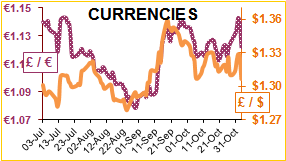Last Friday May wheat futures closed at £147/t, by Wednesday had drifted down to £144.75, and on Thursday rebounded back to £147. On Thursday the Bank of England increased interest rates, and Sterling fell by two cents against both the € and $, whilst the FTSE 100 shot up touching 7,581 on Friday – higher than the record high close of 7,556 on 12th Oct; indicating that money from the currency markets has moved into stocks and shares.
The Matif wheat prices followed a similar trend to the UK this week, but EU exports are about 25% lower than last year due to their exclusion from the export markets by the Russians. The USDA Russian correspondent believes Russia will harvest 83 Mln T wheat (1 Mln T more than previous estimates), and that Russia intends to improve its export infrastructure to draw wheat from Siberia, the Urals and the Volga Valley. In the Ukraine, wheat planting is over 95% complete. The French Farm Ministry believe that their feed wheat planting is 80% complete (75% last year). In the US, wheat touched a new contract low as funds sold more wheat and are now about 11 Mln T short. They are also about 22 Mln T short of maize (almost a record) as December futures prices move sideways at about $3.48/b. The size of these fund positions ahead of next week’s USDA report could lift prices if the shorts have any cause to worry. Although more than 50% of US winter wheat is rated good/excellent, and planting is about 85% complete, some analysts expect a reduced wheat acreage as US farmers continue their trend of planting alternative crops instead.
The protein quality of US soya is about 1% less than normal, so that the protein in whole soya is about 34% (normally 35%) resulting in Hipro soya now being sold at 46.5% (normally 47.5%). This will probably mean that some US livestock producers on fixed formulations will have lower productivity than normal, whilst those who reformulate will use slightly more soya this year. The latter will reduce the availability of exports, and the possibly the price of US livestock produce. The US soya harvest is about 85% complete. The funds are about 7 Mln T long of soya.
Despite the generally dry weather in Brazil, soya farmers have managed to plant 30% of their crop (5-year average 34%). However this overall figure obscures the detail. It has rained in Mato Grosso in the north so the planting is in earnest with 44% complete (5-year average 45%), which is 18% higher than the previous week. In the west of the state they are 80% planted, in the centre 58% is planted, and 5% in the north-east where it is dry. Parana is 70% planted, the dry state of Goias is 6% complete (5-year average 28%), and Rio Grande do Sul is only 3% planted. There is some discussion that if it is too dry and too late to plant soya, farmers have the option of planting cotton instead. It has been so dry in the Goias that forest fires have been prevalent, one destroying a third (68,000 acres) of the Chapada dos Veadeiros National Park.
In Argentina farmers have just started planting their soya (2% complete) and are waiting for the promised reduction in the 30% soya export tax from January. Planting normally reaches 50% in early December, so if the government makes a confirmatory announcement in the next month, then soya acreage could increase; however questions are being asked whether the government can afford to reduce the tax by the six percent a year for two years (half a percent per month) as Macri had promised when he came to power. Local economics favours soya planting over maize, but the tax is a disincentive. It is possible that farmers will continue to hoard soya until the tax is sufficiently reduced.
In 1503, Vasco da Gama was leading a fleet of ships from Portugal to India. The Esmeralda sank and was finally located off Oman in 2014, where archaeologists recovered the ship’s astrolabe. The seven inch bronze disk was identified using a 3-D scanner, and is the earliest known marine astrolabe. It was used to measure the height (in 5 degree increments) of a celestial body above the horizon, day or night, to determine local latitude. It is marked with the coat of arms of Manuel I, King of Portugal (1495-1521). A nice thing to own, but it will not replace the Sat-Nav in your car.





















